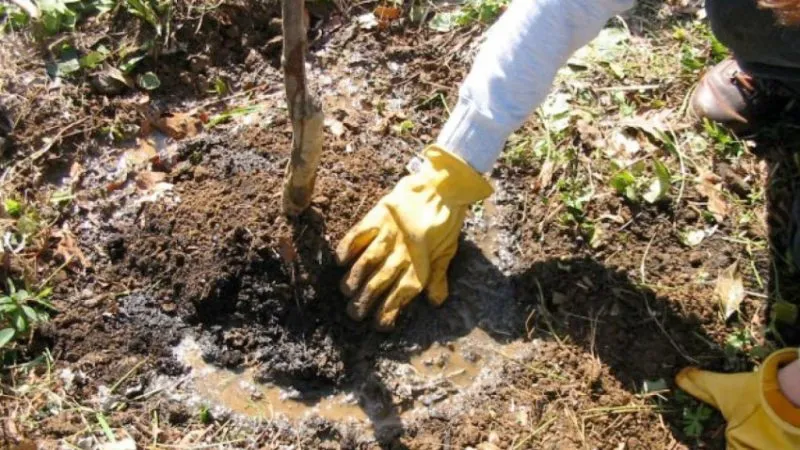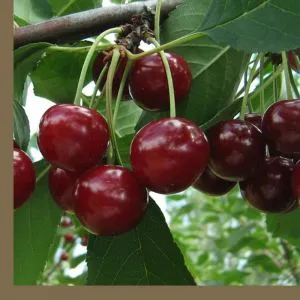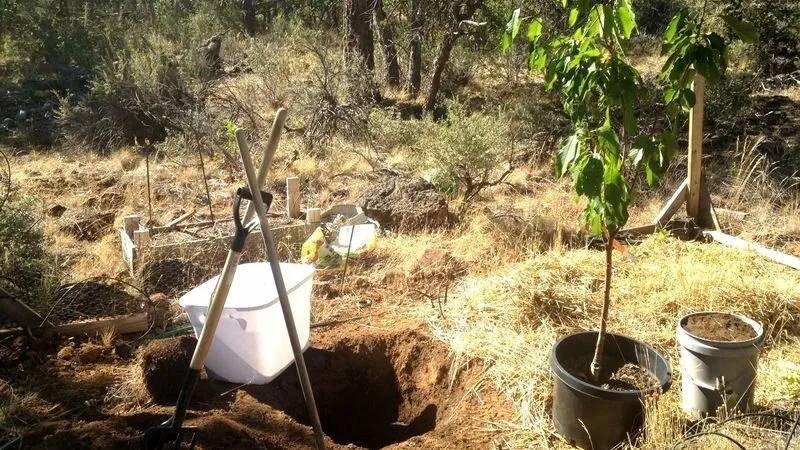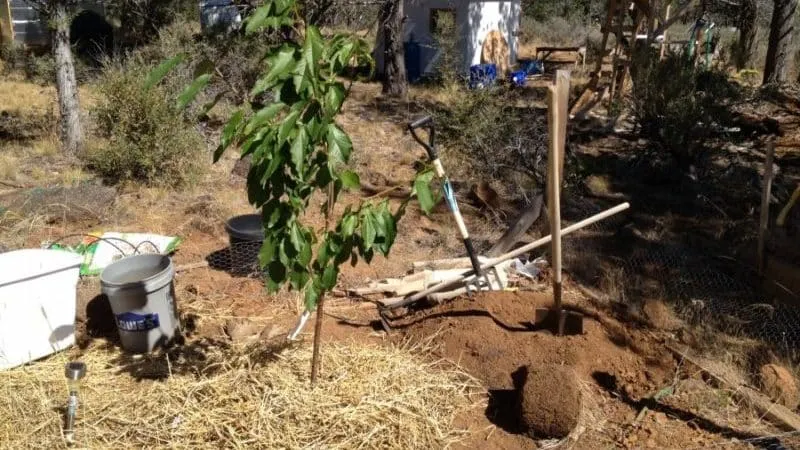The ideal time to plant garden crops is early spring or mid-autumn. However, some gardeners choose the height of summer — July — for this task. The warm weather attracts them, as the risk of seedlings freezing is close to zero. Cherries are particularly popular for July planting: this juicy and sweet berry is a favourite of many. Let’s explore how to plant cherry seedlings in July and what recommendations to follow.
Table of contents
Is It Possible to Plant Cherries in July?

For July planting, seedlings with a closed root system are suitable; they grow in plastic containers rather than open ground. Such cherries adapt quickly to their new location because the root ball from the container is planted along with the roots. The roots remain unharmed, and the flowering period begins earlier. Gardeners face no difficulties in storing planting material, as it can be purchased well in advance. In July, there are no sudden temperature drops, which often occur in spring and autumn, so the seedling is protected from cold snaps.
The downside of July planting is that seedlings with an open root system are unsuitable. Such cherries are planted in spring or autumn. In summer, plants with exposed roots experience significant stress, negatively affecting yield and fruit quality. They often fall ill, and the berries grow sour and misshapen.
Optimal Planting Time
The planting day depends less on the exact date and more on climatic conditions, sunlight, and humidity. Gardeners recommend planting cherries in the morning on a windless, sunny day. The optimal air temperature is up to +20°C, which is why morning planting is preferred before the sun gets too intense.
Note! According to the lunar calendar, the favourable months for planting are March, April, May, September, and October. July is not on this list.
There should be no rain, hail, or other precipitation. The ideal humidity level is around 75–80%. To ensure the cherry establishes itself before autumn, many gardeners plant it in early July.
Suitable Varieties
When selecting a variety, consider yield, ripening time, hardiness, growing requirements, disease resistance, and purpose. Among European varieties suitable for July planting are:

- Morello. A low-growing tree with arching olive-green shoots and dark red fruits with tender skin. The flesh is sweet-sour, ideal for processing. Morello is resistant to fungal diseases.
- Stella. A versatile variety with pink, oval-round berries. The flesh is juicy and delicate. This cherry is grown for both commercial and personal use.
- Napoleon. A hardy, early-ripening variety. The tree has a bushy growth habit, saving space in the garden. The skin is glossy, and the flesh is dark red. The taste is rich, sweet, with a pleasant tartness.

Bing Cherry - Bing. A mid-season variety, easy to grow. The flesh is juicy, with a delightful flavour. Bing is fast-bearing and versatile in use.
- Van. A self-fertile, hardy variety grown across Europe. The fruits are round, dark red, with firm skin. The taste is aromatic, sweet-tart.
Selecting and Preparing the Planting Site
Cherries are demanding when it comes to location, so preparation should begin early. From April, dig the soil to a spade’s depth, clear it of debris and old leaves, and remove weeds and other plant residues. It’s advisable to pour boiling water over the soil once the snow melts to eliminate larvae and bacteria that overwinter there.
The ideal soil is loamy, rich in organic and mineral matter. To enhance fertility, add well-rotted manure or poultry droppings two months before planting (8 kg per 1 m²).
Cherries dislike overly wet soil, as it causes root rot and reduces yield. Avoid planting near marshy areas or high water tables. The best location is a sunny, elevated spot along a fence on the south-eastern side of the garden. If the soil is acidic, add 400 g of dry lime per 1 m². The pH level should not exceed 7.
Selecting and Preparing the Seedling
Gardeners should choose own-rooted or grafted plants with 3–4 skeletal roots. Such specimens bear fruit earlier and adapt better. The seedling should be about 80 cm tall, either one or two years old. Check for cracks, spots, or signs of rot — these indicate disease or damage.
After purchase, remove the leaves to prevent dehydration. Moisten the roots in warm water and wrap them in cloth or plastic. Before planting, trim the main roots to healthy wood and dip them in a solution of RootBoost. This enhances immunity to bacterial and fungal diseases, accelerates root and shoot growth, and boosts productivity.
How to Plant Cherries Correctly in July
Summer planting is quick if planned in advance. Gather the necessary tools: a spade, a wooden stake for support, garden netting, and a bucket of water. Expert recommendations will help ensure successful planting and growth.
Planting Guide
Start by digging a hole 80 cm wide and 60 cm deep. The spacing between low-growing varieties should be at least 3 m, while tall varieties need 5–6 m. Cherries are typically planted individually or along garden structures. Follow these steps:
- Place a wooden stake in the centre of the hole as a support.
- Add a 10 cm layer of commercial soil at the bottom.
- Remove the seedling from the solution or water.
- Position the root collar 4 cm above ground level.
- Cover the seedling with loose soil on all sides.
- Create a shallow trench 15 cm from the base and pour in 2 buckets of water.
- Tie the cherry to the support with a cotton strip.
- Protect the trunk with garden netting.
Some gardeners struggle to identify the root collar. It’s not above the roots or at the graft point — it’s where the roots transition into the trunk. Avoid burying it too deep, as this causes bark rot, forcing the tree to fight for survival instead of establishing itself.
Planting from Stones
A simple way to grow a productive cherry orchard is to use stones from the tastiest, juiciest berries (store-bought cherries won’t work). Wash and dry the stones, then place them in a 5 cm-deep hole. Growth begins in autumn when cool weather triggers stratification. By spring, the first shoots appear. Once seedlings reach 30 cm, transplant them to their permanent spot.
Some gardeners plant stones in flower pots with organic or mineral-enriched soil, growing them indoors before transplanting.
Planting Cherries with a Closed Root System

When planting container-grown cherries in summer, invert the pot while holding the seedling and soil ball in your palm. The drainage holes make it easy to separate the pot from the plant.
Note! Buy seedlings from reputable nurseries. Ask for details: variety name, ripening time, growing specifics. Reviews from other gardeners are also helpful.
Water the seedling beforehand for easy removal, preserving root and soil integrity.
Aftercare
Care involves watering, fertilising, loosening, and mulching. Though drought-tolerant, cherries need watering throughout the growing season. Young trees require 3–6 litres of sun-warmed water per session. Increase amounts in dry southern regions; reduce in rainy weather. Loosen the soil first to retain moisture and improve aeration — this also prevents diseases and pests.
Fertilise for the first time during flowering. Use a mineral mix: dissolve 5 g urea and 10 g potassium chloride in 5 L water. This nitrogen-potassium blend stimulates flower development and improves fruit quality. Two weeks later, apply organic fertiliser: mix 10 L water, 2 L manure, and 500 g wood ash per plant. Water thoroughly after application.
Mulch the soil around the cherry consistently. Bark or wood chips work well — they retain moisture, protect roots from overheating, and suppress weeds.
Tips from Experienced Gardeners

For consistent, delicious harvests, focus on disease prevention, pest control, and pruning:
- Prune cherries from the 2nd or 3rd year after planting. Remove suckers and thin shoots from young trees. Use sharp shears to cut diseased or damaged branches. Do this before active sap flow, around late March or early April.
- Apply preventive treatments in spring, summer, and autumn. To guard against scab, leaf spot, and black rot, use a urea solution (1 tbsp per bucket of water) or FungoProtect spray. Deter pests with soap spray or Bordeaux mixture.
In autumn and winter, protect against rodents with plastic netting — it allows airflow while keeping voles, rats, and hares at bay.
Conclusion
For July planting, choose container-grown seedlings: they adapt quickly and resist disease. Buy from nurseries, research suitable varieties, and prepare a sunny, well-fertilised spot. Plant the seedling, backfill with soil, and stake it. Water with warm water, fertilise, and mulch for best results.







